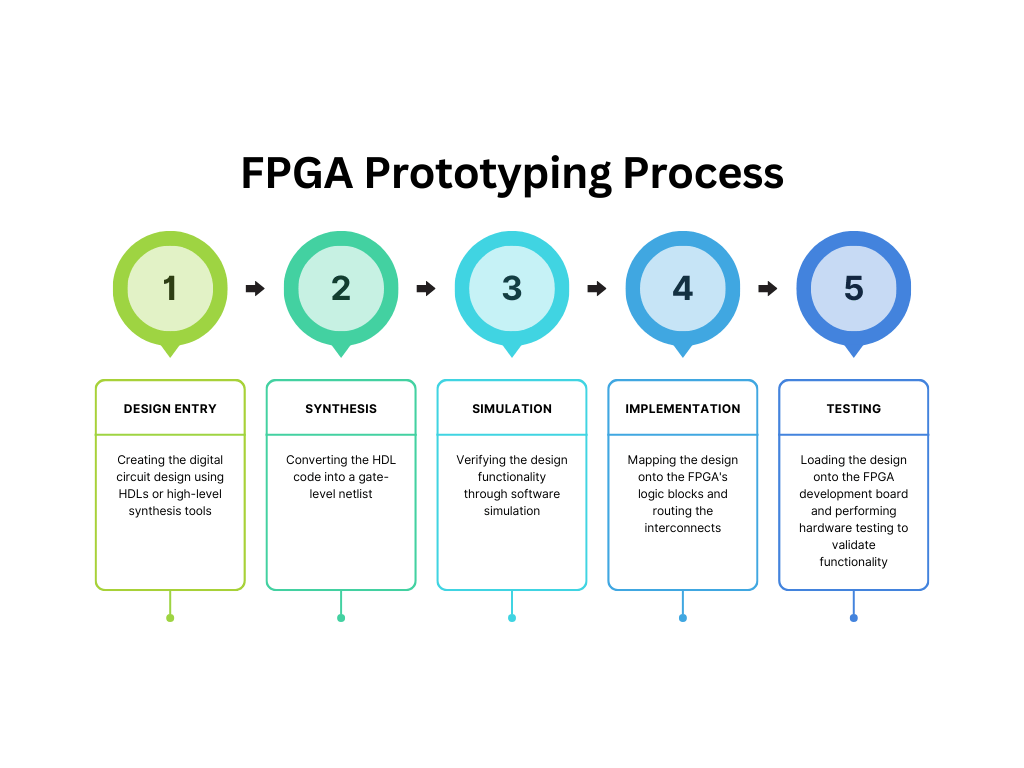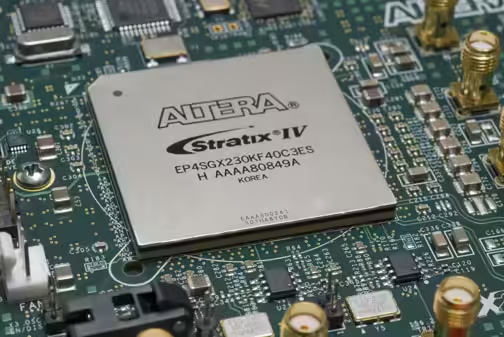Introduction to FPGA Prototyping
FPGA (Field-Programmable Gate Array) prototyping is an essential step in hardware development. It allows designers to test and validate their digital circuit designs before committing to final production.
Unlike traditional integrated circuits (ICs), FPGAs can be reprogrammed to meet specific application needs, which can be the same for microcontrollers. This flexibility makes FPGAs especially valuable during the prototyping phase, where frequent design changes and modifications are common.
Hardware engineers prefer FPGA prototyping because it enables quick and affordable hardware reconfiguration. This saves time and money during development.
Historical Context
The journey of FPGA technology began in the mid-1980s with the introduction of the first commercial FPGA by Xilinx. Early FPGAs were basic, with few logic gates and connections, but they were a big advancement in reconfigurable computing. FPGA technology has improved a lot over the years, adding features like memory blocks, DSP slices, and fast transceivers.
These advancements have expanded the applications of FPGAs across various industries, including telecommunications, automotive, and aerospace. FPGA technology has advanced with milestones like partial reconfiguration and hardware-software co-design, improving its versatility and performance.
Benefits of FPGA Prototyping
Numerous advantages to using FPGA prototyping appeal to hardware developers. FPGAs are flexible, allowing engineers to easily make changes to their designs during testing to meet new requirements. Furthermore, engineers can reuse FPGA configurations across different projects, saving time and resources.
Cost efficiency is another key benefit, as using FPGAs for prototyping reduces the need for multiple iterations of physical ICs, ultimately lowering development costs. Moreover, FPGAs facilitate rapid prototyping, which can speed up the development process and bring products to market more quickly. Lastly, FPGAs offer improved performance through features such as parallel processing, making them well-suited for handling complex computations.
Components of an FPGA Prototyping System
An FPGA prototyping system typically consists of several key components, each playing a crucial role in the development process:
Development Boards like Xilinx Zynq and Altera Cyclone provide hardware interfaces. HDLs like VHDL and Verilog describe FPGA designs.
Synthesis Tools like Xilinx Vivado and Intel Quartus convert HDL code into bitstreams. Simulation Tools like ModelSim and VCS verify design functionality. Debugging Tools like ChipScope and SignalTap monitor and debug FPGA operations.
FPGA Prototyping Process
The FPGA prototyping process involves several key steps to ensure a successful design:
- Design Entry: Creating the digital circuit design using HDLs or high-level synthesis tools.
- Synthesis: Converting the HDL code into a gate-level netlist.
- Simulation: Verifying the design functionality through software simulation.
- Implementation: Mapping the design onto the FPGA’s logic blocks and routing the interconnects.
- Testing: Loading the design onto the FPGA development board and performing hardware testing to validate functionality.

Design Optimization Techniques
Optimizing FPGA prototyping involves several techniques to enhance efficiency and performance:
- Resource Optimization: Ensuring that the FPGA’s resources, such as logic elements, memory blocks, and DSP slices, are used efficiently.
- Power Management: Implementing techniques to reduce power consumption, making the design more power-efficient.
- Timing Optimization: Ensuring the design meets the required clock speed and operates correctly.
- Area Reduction: Minimizing the physical area occupied by the design on the FPGA.
- Performance Tuning: Fine-tuning the design for maximum performance and throughput.
Common Challenges in FPGA Prototyping
FPGA prototyping comes with several challenges:
Design Complexity: Managing large and intricate designs requires careful planning and resource management. As designs grow in complexity, ensuring that all components function together without issues becomes more challenging.
Furthermore, debugging difficulties can arise. Identifying and fixing bugs in FPGA designs can be tricky without the proper tools. Debugging tools like ChipScope or SignalTap are essential, but even with these, pinpointing the exact issue can take time.
Moreover, timing issues are often encountered. Achieving timing closure and meeting the required clock speed can be difficult. Ensuring that the design meets all timing requirements is crucial for reliable operation.
In addition, resource constraints can limit the design scope. Limited resources on the FPGA mean designers must optimize their designs to fit within the available logic elements, memory, and other resources.
Finally, power consumption is a significant concern. High power consumption can be a problem in power-sensitive applications. Efficient power management techniques are necessary to ensure the design operates within acceptable power limits.
Applications of FPGA Prototyping
FPGA prototyping is used in a variety of industries to develop and validate innovative solutions:
Industry applications include telecommunications, automotive, aerospace, consumer electronics, and medical devices. In telecommunications, equipment is used for phone networks. The automotive industry uses technology for self-driving cars, safety systems, and entertainment in cars. In aerospace, technology is used for satellites, radar, and airplane systems.
Consumer electronics use technology for smart devices, video game systems, and home automation. Medical devices use technology for medical imaging, tests, and monitoring devices.
Future Trends in FPGA Prototyping
FPGA prototyping is evolving with several exciting trends. Companies are increasingly using FPGAs in AI and machine learning to accelerate tasks. They can be reconfigured for improved performance in data-heavy jobs.
The increase in IoT applications is increasing the need for FPGAs in smart sensors and edge computing. FPGAs offer the processing power and flexibility needed to meet various requirements.
Increased miniaturization is another trend, with advances in technology leading to smaller, more powerful FPGAs. This trend enables their integration into more compact devices, broadening their application scope.
Advanced tools are now available to help design and optimize FPGA prototypes. These tools improve the design process by providing better synthesis and implementation capabilities. FPGAs are performing better and can now be used for more complex tasks.
Conclusion
FPGA prototyping is a powerful and versatile approach to hardware development, offering significant benefits in flexibility, reusability, cost efficiency, and performance. The process has several important steps: design entry, synthesis, simulation, implementation, and testing. Each step is supported by different tools and components.
Although designing complex systems and debugging them can be challenging, the benefits typically outweigh these obstacles. The benefits include addressing timing issues, managing resource constraints, and reducing power consumption.
Multiple industries use FPGA prototyping, including telecommunications, automotive, aerospace, consumer electronics, and medical devices. In the future, AI, IoT, smaller devices, better tools, and improved performance will keep changing FPGA prototyping. This makes it an exciting area with lots of room for new ideas and progress.
FAQs
What is FPGA prototyping and why is it important?
FPGA prototyping involves using Field-Programmable Gate Arrays to test and validate digital circuit designs before production, allowing for quick and cost-effective design changes.
What are the benefits of using FPGA for prototyping?
Benefits include flexibility, cost efficiency, rapid prototyping, and the ability to handle complex computations through parallel processing.
What are the key components of an FPGA prototyping system?
Key components include development boards, hardware description languages (HDLs), synthesis tools, simulation tools, and debugging tools.


No comments yet